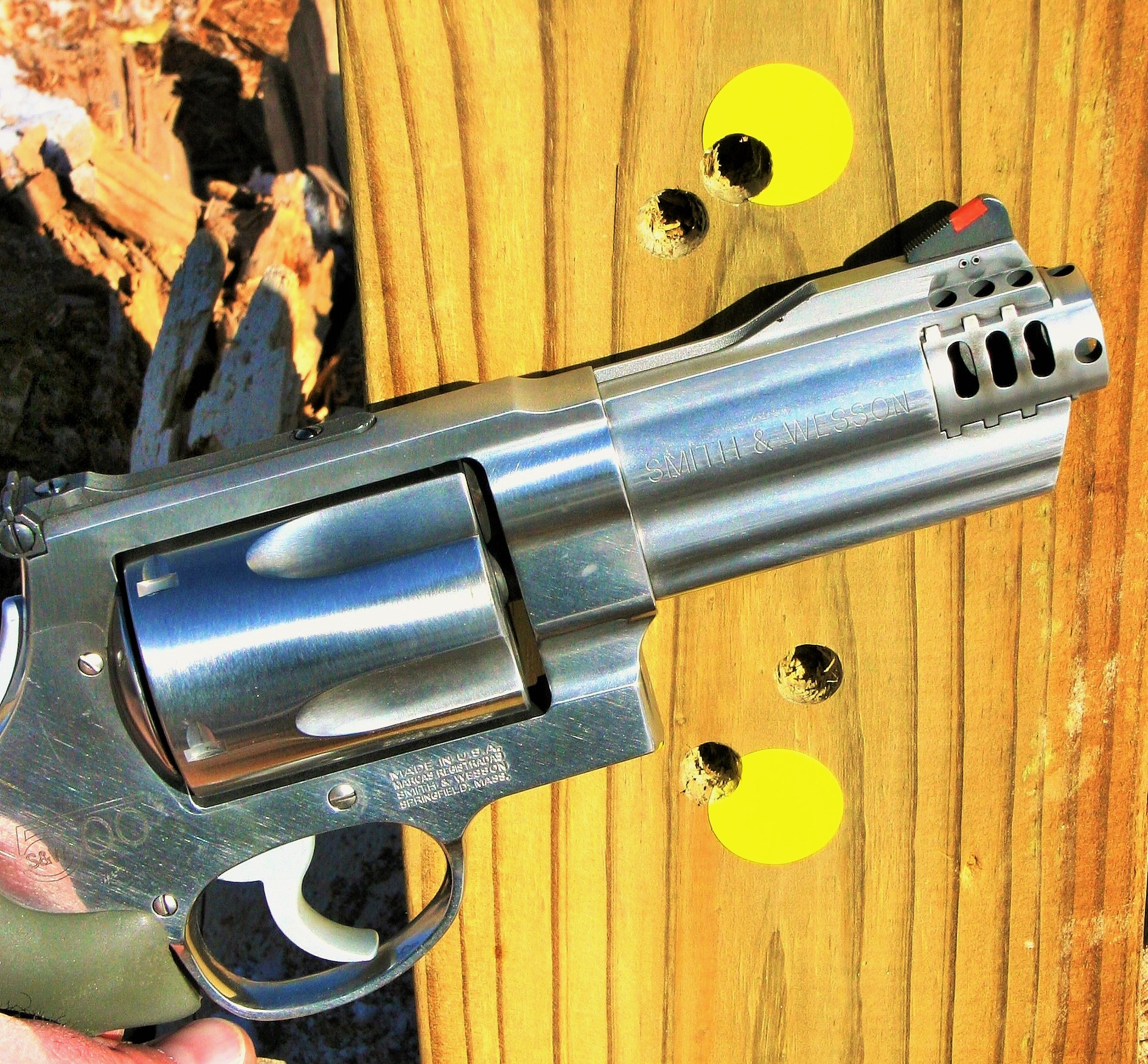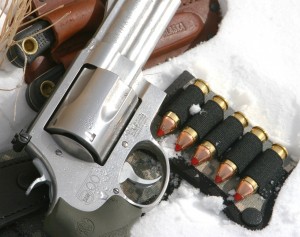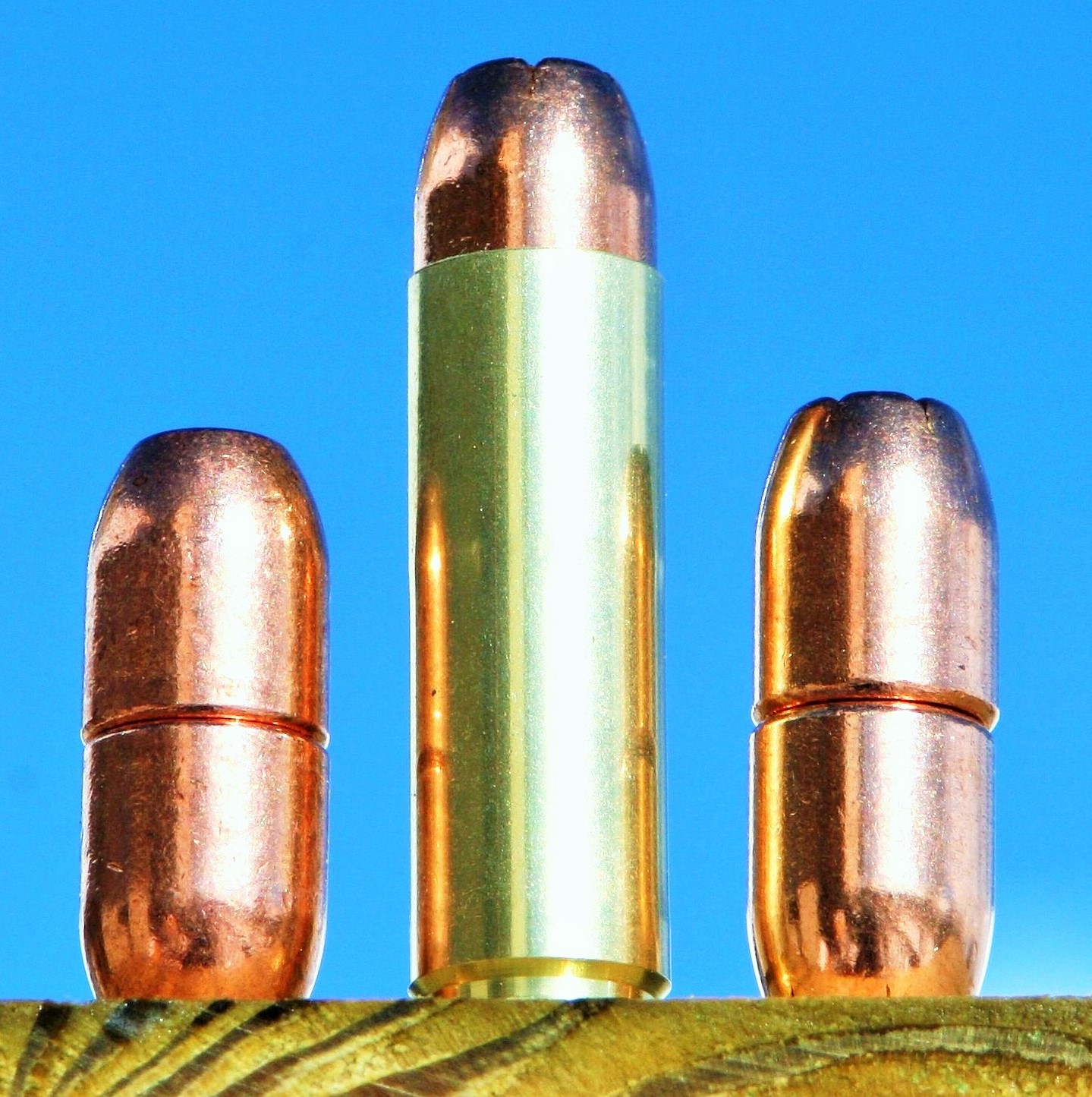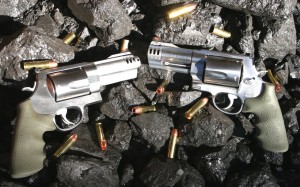
Just as a Ferrari does not have to be driven with your pedal to the floor, the awesome 500 Smith & Wesson need not be pushed to the max to be useful and fun. The author has developed many moderate, effective loads which can comfortably be handled by any shooter who can manage the 44 Magnum.
I was certain that I was finished testing big bore revolvers when I last wrote about my results with the .45 Colt. The 44 Magnum had been covered earlier, as well as the 454 Casull, the 460 S&W, and even the .480 Ruger. Then it happened. My brother told me about a distributor having a special sale on a 4” 500 S&W OD Carry Kit at an almost give-away price. It came with special Hogue Olive Drab green grips, a DeSantis digital OD holster, and a matching mini 5-round belt cartridge holder. It also came in a very big OD green S&W hard case. Not even checking with my editor, the money was on its way the very same day. I just knew he would be interested in a story that made the 500 S&W manageable for most any gunner to shoot..
Up front, know that the project was a huge success. If you can handle full-power loads in a 44 Magnum, you will find loads here that can comfortably be shot in the 4” 500 S&W; and they would be even more shootable in a longer barreled version. Should you feel just a little brave, you will also find loads to take you a little bit beyond, and if really bold, to very exciting levels.
Chapter 1: The Biggest, Meanest Revolver
Click to LOAD DATA SHEET
I first shot the 500 S&W at a writer’s session during SHOT Show in Las Vegas several years ago. Winchester had just come out with a new load for the cartridge featuring a 400 grain Nosler Partition at 1,800 fps! It was fun to see how badly most shooters flinched as they took their turn with the big one. In fact, many only fired one shot, as after that, their brain knew what was coming. I forced myself to fire a whole cylinderful, and walked away thinking that there was no way I would ever want or need a gun that large. I’m also certain that many shooters who have never even fired a full-house 500 think the very same thing. As I completed my most recent article on the 45 Colt, I realized what I had been preaching all along- though handloading- you can make...
BIG cartridges shoot and recoil like a much smaller one. That handloading challenge and the bargain price, forced me to prove my words.
Everything about a 4 inch barreled 500 S&W is huge; the frame, the cylinder, and especially the hole in the front. Hornady provided factory ammunition in three types and weights, and I gathered up a broad variety of bullets from them, Barnes, Sierra, and Speer. I was determined to make this gun comfortable to shoot while still being very effective for hunting. Bullet weights ranged from 275 grains up to 500 andwith proven results from the 45 Colt, I was going to attempt double-bullet, 300 grain bone breakers, for a total payload of 600 grains. And it still had to be controllable for the seasoned shooter. While this was a mighty tall order, were my goals realistically attainable?
Chapter 2: Bullets and Powders
The requirement to lubricate the case, due to the steel FL die construction, actually turned out to be a very pleasant surprise.
Hornady brass and die set was used for all loads. I also ordered a taper crimp die to be used on the bullets without cannelures, originally intended for the 50 AE cartridge. A surprise came in two different ways when I got my order in. Hornady shipped me a 4 die set which included a taper crimp die, and the sizer die was not carbide, but regular steel, requiring lubrication (they were out of titanium coated sizers at the time). Including a taper crimp die in the set showed that people who know what they are doing had the foresight to include it, as most readily available .500 diameter bullets were designed for the 50 AE. Headspacing on the case mouth, you cannot use a traditional roll crimp on the 50 AE cartridge.
The requirement to lubricate the case, due to the steel FL die construction, actually turned out to be a very pleasant surprise. First off, the size of the 500 brass brought back very fond memories of the thousands of .45-70 rounds I loaded for my very first centerfire rifle over 40 years ago. Secondly, the slow burning ball powders used in full-power handgun rounds always leave heavy powder residue on cases, even after considerable tumbling. A carbide die only serves to burnish it harder into the surface of
the brass. In contrast, I have found Redding Sizing Die Wax actually seems to clean the residue somewhat, and my wiping off of the lube afterwards helps...
to keep the cases shinier and cleaner. Besides, a 500 is not the type of cartridge that you will shoot and load hundreds of rounds at a session. The Hornady taper crimp die can additionally provide a bit of a modified roll crimp, if you adjust it downwards enough. All 50 AE type bullets benefited from its proper use, resulting in bullets that stay put under the sometimes considerable recoil.
Sierra makes two good looking bullets for the 500- a 350 grain JHP and a 400 grain JSP.
From Hornady, I obtained their 300 grain 50 AE XTP, 350 grain cannelured XTP meant for the 500, as well as a blockbuster looking 500 grain JFP. Barnes provided their huge-cavity, all copper bullet in 275 grains, and very modern looking spire point XPBs in 325 and 375 grains. Sierra makes two good looking bullets for the 500- a 350 grain JHP and a 400 grain JSP. Finally, from Speer came two 300 grain styles; a TMJ FP and Gold Dot HP- both meant for the 50 AE, without any cannelure, and a 325 grain Uni-Cor HP, also for the AE. For this test, I did not have access to any cast bullets, but I do look forward to later giving them a try.
As my focus was on achieving moderate, effective loads, shootable by those who can handle heavy 44 Magnum rounds, I narrowed my propellants to those suitable for the task. From Accurate, I used 5744, and No. 7 and 9; Hodgdon provided Clays, Universal, HS-6 and Lil’Gun. Only Federal 210 large rifle primers were used in the Hornady brass. As discussed, cannelured bullets were roll crimped, while AE style projectiles were secured using the taper crimp die. All charges were dispensed by the RCBS ChargeMaster Combo.
Chapter 3: Specific Loads, Special Results
Virtually every bullet has loads that I classified as Effective and Comfortable to shoot. That means, to my hands, recoil felt very similar to top loads in a 44 Magnum. As most handgun shooters can handle a 44, they also could very well handle loads so identified in the data chart.
Shooters can start light, and work slowly up to a level they are comfortable with.
The next recoil category is termed Moderately Heavy Recoil. Though not wanting to shoot a steady diet of these loads, a person capable of shooting the first category of rounds could also handle a few cylinders of the...
medium recipes.
The final group is described as Heavy and Fast Recoil- a cylinder full of these will get everyone’s attention at the very first shot. Aside from showing off to your friends, few
beasts would ever require going to loads this powerful. The shooter is much better off using a big bore rifle from the start, eliminating the need to ever draw a handgun as backup.
With bullets up to 300 grains, Hodgdon Clays starting loads of only 11 to 12 grains produced 562 ~ 653 ft. lbs. With the same bullets, charges as high as 19 grains delivered a more impressive 1,053 ~ 1,218 ft. lbs. Shooters can start light and work slowly up to a level they are comfortable. Clays was extremely clean burning, sealing off the case necks very well, eliminating the traditional ball powder blow-back and sooty brass. The top loads are similar to the performance level of the 50 AE, without the shooter having to get down on his hands and knees to look for tossed brass. That alone is a big plus to me.

Stepping up slightly in performance, but still overlapping the velocities delivered by Clays, Hodgdon Universal powder achieves 1,200 ~ 1,500 ft. lbs. with many of the loads still being rated as Effective and Comfortable to shoot. The addition of Accurate No. 7 under the 275 grain, huge hollow cavity Barnes XPB delivers 1,578 fps and 1,520 ft. lbs from effectively only a 3” barrel. Its solid copper construction would result in a devastating wound channel in soft tissue and hold together well enough to break a lot of bone going in. But with its great expansion greatly increasing frontal area, I would not expect deep penetration in game. With the same bullet and lighter charges of Clays, you still would be well armed against most critters.
All of the milder rounds with the 300 grain Hornadys, or the Speer Gold Dots or TMJs are very easy on the shooter but still very effective on game. 300 grain .50 caliber bullets, expanding or not, can deliver a tremendous blow at handgunning distances. The same can also be said for the slightly heavier 325 grain Speer Uni-Cor bullet. Tested loads produced energies of 621 to over 1,400 ft. lbs., offering up many recoil levels for the shooter to...
accommodate varied needs.
Virtually identical performance can be had using the same weight Sierra bullet, using almost the very same charges.
A same weight bullet with an altogether different personality is the spire point Barnes XPB. Loads using Universal run from 1,235 to 1,439 ft. lbs., jumping to over 1,800 ft. lbs. with Accurate No. 7, topping out at 2,165 ft. lbs. over Lil’Gun- all from effectively only a 3” barrel. Surprisingly, I realized similar energies from the Hornady 300 grain FTX factory round. Powered by a case full of slower burning powder, the blast and flash from this round is impressive on both ends of the gun. It would be devastating on medium game at longer distances from a more traditional longer barreled version of the 500.
Hornady’s 350 grain factory load is also very powerful from the short barreled Smith, delivering 1,456 fps and over 1,645 ft. lbs. This bullet was specifically designed to hold up to the heavy blow of the 500. Effective and controllable rounds were developed using this bullet over Universal powder, producing 727 to over 1,400 ft. lbs. You can step up on this performance by loading HS-6 or Accurate No. 7 for 1,512 or 1,765 ft. lbs. respectively; definitely not in the easy-to-shoot category. Virtually identical performance can be had using the same weight Sierra bullet using almost the very same charges. The Sierra does have a somewhat longer nose section in front of its cannelure with a correspondingly shorter portion projecting into the case. With moderate loads though, this has no effect on delivered performance in the field.
Stepping up slightly to 375 grains, the spire point Barnes XPB begins at moderately heavy performance, topping out over Lil’Gun for almost 1,840 ft. lbs. For its weight, I am certain you could not load a tougher, deeper penetrating bullet that could expand and yet hold onto probably 100% of its weight. Loaded to 2.300” in length, it is a clear standout from what one would consider a traditional handgun round should look like.
Jumping up to the heavy weights with the flat point construction of the 400 grain Sierra and 500 grain Hornady, one realizes that at most any reasonable velocity, a lot of muscle and bone could be penetrated by either of these impressive slugs. I still could obtain effective and comfortable loads with either bullet using Universal, or could spice things up...
quite a bit over HS-6 or No.7 powders. The Hornady factory 500 grain load could almost be duplicated with a very modest charge of only 17 grains of Universal, duplicated with 21.8 grains of HS-6, or bested by 26 grains of Accurate No. 7. The same powders also deliver slightly higher velocities under the 400 grain Sierra. Either bullet, I am certain, would whistle though most hogs, black bear, elk, or moose, and bury itself deep into the ground on the other side.
Chapter 4: Double Your Fun- Double Bullet Loads

At over 1.6” in length, the extremely sturdy case of the 500 beckoned for a double bullet load just as I had proven successful in the recent 45 Colt article. In the Colt, I safely drove two 185 grain bullets to reasonable velocities. Besides being a fun and interesting round, it would make for a very devastating up-close finishing shot on game. Running calculations on QuickLOAD, it readily became apparent that two 300 grain bullets could be safely driven to respectable speeds. So I tried two 300 Hornady XTPs base to base (front bullet facing forward, bottom bullet backwards) over Accurate 5744, Hodgdon HS-6, and Accurate No. 9. Speeds registered 849, 928, and 996 fps respectively, while energies delivered were 960, 1,147 and over 1,320 ft. lbs. The first load with 5744 actually makes the grade and gets a rating of effective and comfortable to shoot. You could load an expanding bullet on top and the TMJ underneath; or for that matter, an expanding bullet upside-down, rendering it non-expanding. But always… only load base to base- never nose to base. The Speer TMJ FP also delivered almost identical performance over the same charges as the Hornady bullet. One experimental load, which I shall not share, actually delivered almost 1,200 fps (1,900 ft. lbs.) with a double 300 grain payload. Shooting it was an experience I shall never forget!
Efforts to shoot a 300 grain bullet, under a 350 grain did not work so well, due to the limits of case length.
The real proof of the potential of double bullet loads in the field came when I tried them out on a length...
of 2×6” wood. At 7-feet, one bullet regularly struck a 1” adhesive label, with the other almost touching. Back at a distance of 21-feet, both bullets struck very close to point of aim and were still less than 1-1/4” apart. The shock and trauma caused by two 300 grain .50 caliber bullets striking simultaneously on a wounded hog or black bear would be extremely devastating. Again, beginning loads using the Hornady or Speer bullets are very controllable to shoot. Efforts to shoot a 300 grain bullet under a 350 grain did not work so well due to the limits of case length.
Summary

Certainly a lot of 500 S&W Magnums rest quietly in many shooters’ safes, having been fired a few times when new and then put away, perhaps for good. The reason why, I would hazard to guess, is that full power loads are nasty to shoot, even for a seasoned handgunner.
Just picking up the 500 S&W handgun or a cartridge, makes me smile. Shooting controllable loads from it, makes me smile even more.
I bought this 4 inch Smith and Wesson because I believed, as a handloader, I could develop moderate, effective loads that could be comfortably shot by anyone who can handle a 44 Magnum. Twenty-nine combinations listed in the data, using projectiles from 275, to a combined 600 grains, clearly make this snub-nosed 50 caliber manageable by many shooters while still delivering a decisive blow on the muzzle end.
You don’t always drive your vehicle as fast as it can go. You don’t always strike a hammer with the hardest possible blow. Nor do you have to load every gun you have right up to the maximum to be a fun and effective tool. There is no reason most shooters cannot also enjoy shooting their .50 caliber revolver for just plain fun, or to carry it for defense against game such as hogs or bear using many of these moderate loads. Just picking up the 500 S&W handgun or a cartridge makes me smile. Shooting controllable loads from it makes me smile even more.